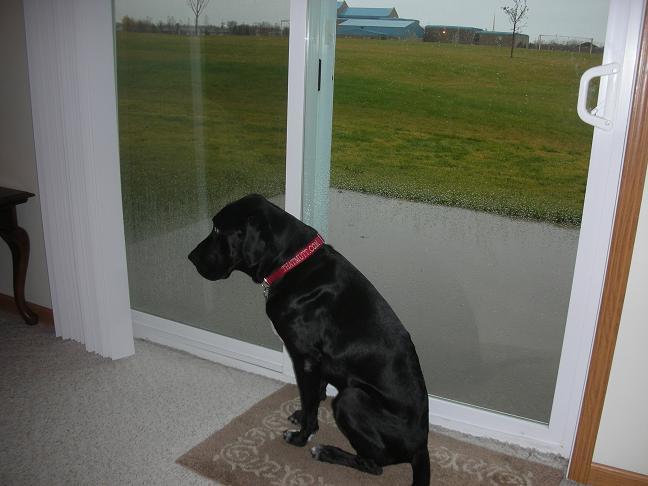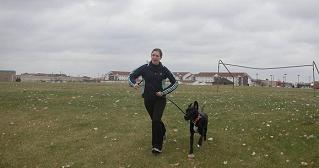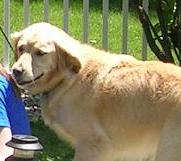Dog keeps barking
I often refer to the field behind our townhouse as our backyard. Really, we live right on the edge of a city-owned soccer field. My mutt Ace and I had this field all to ourselves from November through March. But now that it’s warmer, dozens of people run in that field each day.
We have a large, glass patio door that looks out onto the field. My dog keeps barking every time kids, dogs, runners or soccer players are out there.
My mutt is not used to seeing anyone in “his” yard. So now he has an annoying new habit of letting me know every time anyone is outside. It’s not so much the initial barking that gets to me, it’s how he doesn’t shut up until I scold him two or three times or send him to his bed. When I can’t control my dog, I start to lose my temper.
I now have to think twice about leaving Ace loose when I leave, because he might just sit at the window and bark at the people outside. Seriously, even as I’m upstairs writing this, I just had to go down and tell Ace “No!” because he was barking at people in the field. OK, twice while writing this post.
The problem is, after six months of winter, Ace is not used to seeing people in the yard. He now needs to learn how to respond appropriately so that hopefully in a few weeks it will no longer be a big event when the neighbor kids run outside to play catch. After all, they are out there almost every day. Ace should eventually become desensitized to people on “his” turf.
One good thing is even if I do nothing to help train Ace not to bark, he will eventually bark less just because he will get used to seeing people in the yard. Since we share walls with our neighbors, we often hear them slamming cupboards or doors or running up and down the stairs. These sounds no longer get a reaction out of Ace. He’s used to them.
When Ace barks at someone outside, I direct him to his bed in the corner where he is told to lie down and stay. He can still see the window from his bed, so he is not isolated. Instead, he will learn to be quiet and to chill out. If he’s quiet when people are outside, he will sometimes get a treat. This is a combination of positive punishment and positive reinforcement dog training.
If I were to use positive reinforcement only, I would ignore the barking and reward Ace whenever he is quiet. If I were to only use positive punishment, I would correct the bad behavior without rewarding the good. I would tell him “No!” or leash him and pop his collar. Using a shock collar would even be an option.
I could also remove Ace from the situation entirely. I could put him in his kennel or another room or keep him with me at all times. This is the worst way to handle the situation because my dog would not be learning anything.
So I am using a combination of positive punishment and positive reinforcement. For now, the more people who walk by and test Ace, the better. It will give us more practice.

The answer to solving so many dog behavioral problems is to keep exposing the dog to the problem until he becomes calm. If a dog is scared of bikes, he needs to be around more bikes. If he is dog aggressive, he needs to be around more dogs (in a controlled environment).
The issue could be anything.
Lots of dogs are very territorial and bark every time someone walks by the house. Some have extreme leash aggression. Others cry or bark in the car or when they are left home alone. Dogs are diagnosed with “separation anxiety” all the time. Most dogs are hyper when guests visit, and most dogs pull on the leash. Many cry or whine just because they see another person or dog during a walk. Several bark at bikes, strollers and even cars. Some dogs are so anxious that anything could set them off – birds, the wind, trash bags.

Dogs need to experience as much as possible.
The solution to all of these problems is to keep showing your dog the right way to behave in all situations. It often takes dozens or even hundreds of repetitions for a dog to learn a behavior, but it can always be done if the owner is willing to put in the time and patience necessary. There are no shortcuts.
If kids on bikes make my dog bark, then instead of avoiding bikers, I need to expose my dog to as many bikes as possible. Walking the other way every time we see a bike will not help anything.
Ideally, I would get my friends and family members to ride past my dog and I on their bikes every day. I would a “watch” command to get my dog to look at me until he learns to automatically remain calm around bikes. I could also walk with my dog on one side and my bike on the other until he learns that bikes are no big deal
If my dog jumps and runs around like crazy when guests visit, then I need friends to visit more often. When people do come over, I can’t banish my dog to the kennel. He learns nothing that way. It will only makes him more frustrated and excited when he does finally burst out of the kennel.
A dog that is hyper when guests come over should be leashed and then taught to sit and stay on a dog bed or other specific spot and rewarded for being calm. Again, this will take consistency and lots of repetitions from the owner and the visitors.
Excited visitors paying attention to a hyper dog are only rewarding the dog for being hyper.
I can think of several examples where Ace could benefit from more exposure. He still whines in the car pretty often. Instead of leaving him home, I need to bring him along on errands more often so that he learns he is expected to lie down on the back seat and be quiet. He is also nervous when we visit new places.
That only means I need to expose him to more environments and reward him when he is calm. I always look for opportunities where I can bring my dog along.
Keeping a dog isolated only makes problems worse.
A dog that is aggressive around dogs needs to be around calm, socialized dogs more often so that he learns how to act normally.
A dog that is kept away from other dogs and remains unwalked and unsocialized will only become more aggressive, hyper, anxious or out of control.I had a golden retriever who used to make a crying and shrieking sound every time we met someone new. If you have a husky or a German shepherd, you might have some idea of the sound I am talking about. It literally sounds like the dog is shrieking in pain.

I was so embarrassed by these sounds and would keep Brittni home most of the time. That was the wrong thing to do. She needed to get out more so that she could learn how to behave and so that meeting new people and dogs wouldn’t be such an event!
Sometimes owners even unintentionally create aggressive dogs. I’ve seen owners of pitbulls who keep their dogs away from other dogs because they are afraid of the reactions they get from other dog owners.
Instead of exposing their pitbull puppy to as many dogs as possible at a young age, the friendly pup is kept isolated.
When it is older and powerful, the dog is a handful and pulls and barks when it sees other dogs. Simply, the dog hasn’t learned how to act appropriately. Aggressive or not, people are going to be afraid of a barking, lunging pitbull. Each time this happens, the owners are more reluctant to take the dog out, and the dog becomes even more isolated.
The best thing you can do when you get a puppy or a dog of any age is to expose him to everything you can.
Not only should you bring your puppy almost everywhere to see as many dogs and people and places as possible, but he should also be left home alone often so he learns that being alone or being left with other people is OK too.
The good thing is, even if you’ve made some mistakes in the past, it’s never too late to start socializing your dog.
What issue does your dog have? How can you solve the problem?
April miles: 64.7

Lindsay Stordahl
Saturday 23rd of July 2011
I recommend teaching her a command for "watch" so she will eventually look at you no matter what when asked and hopefully automatically when she sees another dog.
Start with no distractions. Use a treat to get her to make eye contact after saying "watch." Once she does this reliably, you can add some distractions - dogs far away or just being outside. Slowly progress to being around more distractions. Use her absolute favorite treats to make it worthwhile and a true reward for her.
I would keep socializing her and taking her to training classes.
Good luck. Thank you for reading my blog.
Tanya
Saturday 23rd of July 2011
Any ideas to help her? She is amazing with people but she lunges and stares hard at other dogs. That is why we took her to the training/daycare, but could it have made it worse? She also had her first chewing furniture incident the day after.
Tanya
Saturday 23rd of July 2011
I brought my new 3 yr old Frenchie to daycare for special dog socialization evaluation to see if she could start group training the same evening. She did both, and we've now noticed her barking as we enter the room she is in, or at the door or people while on a walk. We've only had her one week, but the only time we ever heard her bark before the class/daycare was when she was startled out of a nap
Lindsay Stordahl
Friday 19th of June 2009
No, the dog was just out of control.
hanan
Thursday 18th of June 2009
OK, I saw two dogs at McDonald's running around and barking. I came back, but the other was running and barking. I'm like, does it smell a preditor around? Help me, please. I have to know. I get superstitious easily.